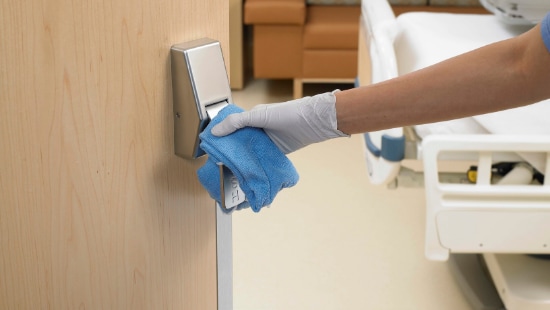The Importance of Environmental Services During a Pandemic

Preventing the spread of pathogens in healthcare facilities is always a priority, but it is especially important in the situation we are in today – a global pandemic. While doctors and nurses work frantically to admit new patients while also treating those already in their care, there is another group of people working in the background, saving lives. These often-unsung heroes are the Environmental Services (EVS) team, quickly preparing new exam and hospital rooms so that patients have a safe place to receive care and heal.
The quality of their work is critical because proper cleaning and disinfection can prevent the spread of pathogens to healthcare works, patients and visitors. The efficiency of their work is equally important because the faster they clean the faster patients can be admitted. EVS is the difference between dirty and clean, contaminated and disinfected, unsafe and safe healthcare environments.
While each healthcare facility has its own environmental hygiene protocols, there is widespread acknowledgement that following a standardized cleaning and disinfection process is the best way for EVS to ensure consistent cleanliness of key surfaces in each patient area in the healthcare environment. Also called high-touch objects (HTOs), these key surfaces are important vectors of infection transmission in healthcare facilities. A recent study found that COVID-19 can survive on plastic and stainless steel for up to 2-3 days.1
Making sure HTOs are properly cleaned is important on a daily basis, but especially during a pandemic like COVID-19.
When each member of the EVS team is trained to clean the same objects in the same order, every time, the opportunity for objects to be missed decreases, as does the opportunity for pathogen spread. It also drives workflow efficiencies because the team understands exactly what to clean, how many people it takes to clean, and how to clean properly. Having reminders like printed flowcharts on the cleaning carts, and wall cards posted inside the EVS closet can also be effective reminders.
However, despite the EVS team’s best efforts, there are some objects that tend to be forgotten. Ecolab’s Patient Room Program provides hospitals and clinics with objective monitoring of the thoroughness and efficiency of cleaning, the data from which is consolidated on digital dashboards to provide visibility to actionable insights. Here is an example of the Top 3/Bottom 3 report from this dashboard - the top 3 HTOs that are cleaned most often, and the bottom 3 HTOs that are most often missed.2 During this unprecedented COVID-19 pandemic, let’s pay special attention to these 3 frequently overlooked HTOs in both the hospital patient room and the clinic’s exam room. Doing so may save lives.
In the hospital patient room:
Most Frequently Cleaned HTOs:
- Toilet Seat (94.10%) 2. Room Sink (93.90%) 3. Call Button (93.90%)
Most Often Missed HTOs:
- Chair (88.20%) 2. IV Pole Grab Area (89.50%) 3. Room Light Switch (89.60%)
In the clinic exam room:
Most Frequently Cleaned HTOs:
- Toilet Seat (94.10%) 2. Room Sink (93.90%) 3. Call Button (93.90%)
Most Often Missed HTOs:
- Blood Pressure Cuff (75.20%) 2. Otoscope Handle (76.50%) 3. Cabinet Handle (80.20%)
EVS teams, the work you do is incredibly important, and it is appreciated. Now more than ever. Thank you for all you are doing to keep hospitals operating during this unprecedented time, and for making hospitals and clinics a safe place for patients to receive the care they need.
References
1. Van Doremalen N, Bushmaker T, Morris DH, et al. Aerosol and surface stability of HCoV-19 (SARS-CoV-2) compared to SARS-CoV-1. The New England Journal of Medicine. DOI: 10.1056/NEJMc2004973 (2020). https://www.nejm.org/doi/full/10.1056/NEJMc2004973
2. Ecolab Data on File



